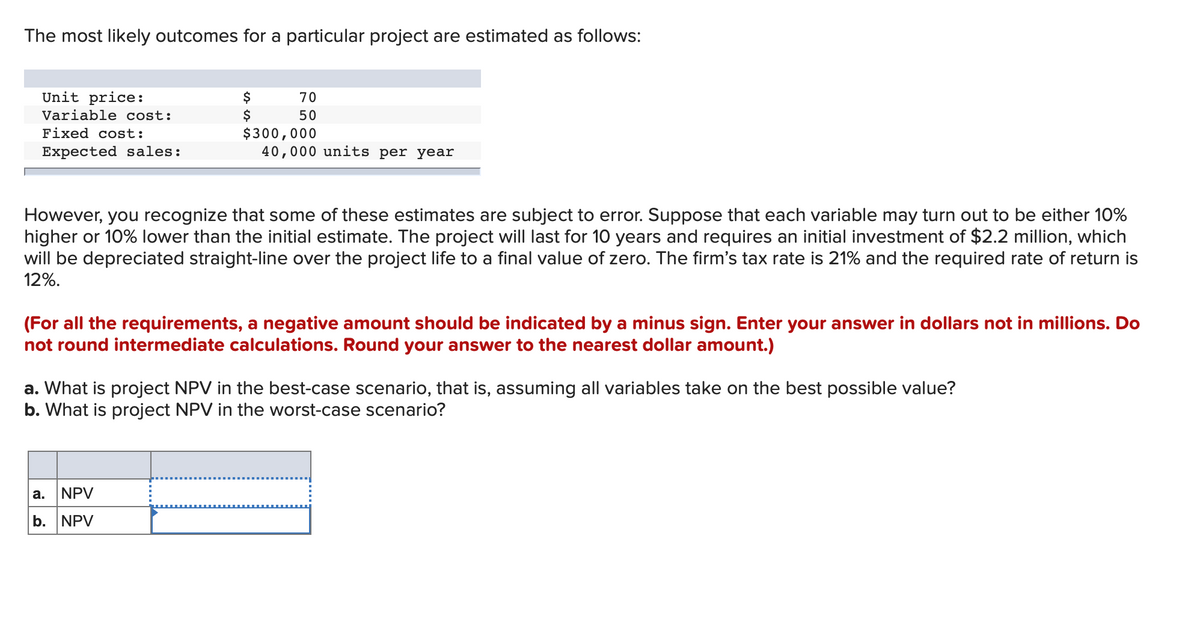(For all the requirements, a negative amount should be indicated by a minus sign. Enter your answer in dollars not in millions. Do not round intermediate calculations. Round your answer to the nearest dollar amount.) a. What is project NPV in the best-case scenario, that is, assuming all variables take on the best possible value? b. What is project NPV in the worst-case scenario?
(For all the requirements, a negative amount should be indicated by a minus sign. Enter your answer in dollars not in millions. Do not round intermediate calculations. Round your answer to the nearest dollar amount.) a. What is project NPV in the best-case scenario, that is, assuming all variables take on the best possible value? b. What is project NPV in the worst-case scenario?
Chapter11: Capital Budgeting And Risk
Section: Chapter Questions
Problem 19P
Related questions
Question

Transcribed Image Text:The most likely outcomes for a particular project are estimated as follows:
Unit price:
$
$
$300,000
40,000 units per year
70
Variable cost:
50
Fixed cost:
Expected sales:
However, you recognize that some of these estimates are subject to error. Suppose that each variable may turn out to be either 10%
higher or 10% lower than the initial estimate. The project will last for 10 years and requires an initial investment of $2.2 million, which
will be depreciated straight-line over the project life to a final value of zero. The firm's tax rate is 21% and the required rate of return is
12%.
(For all the requirements, a negative amount should be indicated by a minus sign. Enter your answer in dollars not in millions. Do
not round intermediate calculations. Round your answer to the nearest dollar amount.)
a. What is project NPV in the best-case scenario, that is, assuming all variables take on the best possible value?
b. What is project NPV in the worst-case scenario?
a.
NPV
b. NPV
Expert Solution
This question has been solved!
Explore an expertly crafted, step-by-step solution for a thorough understanding of key concepts.
This is a popular solution!
Trending now
This is a popular solution!
Step by step
Solved in 3 steps with 2 images

Knowledge Booster
Learn more about
Need a deep-dive on the concept behind this application? Look no further. Learn more about this topic, finance and related others by exploring similar questions and additional content below.Recommended textbooks for you

EBK CONTEMPORARY FINANCIAL MANAGEMENT
Finance
ISBN:
9781337514835
Author:
MOYER
Publisher:
CENGAGE LEARNING - CONSIGNMENT

Cornerstones of Cost Management (Cornerstones Ser…
Accounting
ISBN:
9781305970663
Author:
Don R. Hansen, Maryanne M. Mowen
Publisher:
Cengage Learning

Principles of Accounting Volume 2
Accounting
ISBN:
9781947172609
Author:
OpenStax
Publisher:
OpenStax College

EBK CONTEMPORARY FINANCIAL MANAGEMENT
Finance
ISBN:
9781337514835
Author:
MOYER
Publisher:
CENGAGE LEARNING - CONSIGNMENT

Cornerstones of Cost Management (Cornerstones Ser…
Accounting
ISBN:
9781305970663
Author:
Don R. Hansen, Maryanne M. Mowen
Publisher:
Cengage Learning

Principles of Accounting Volume 2
Accounting
ISBN:
9781947172609
Author:
OpenStax
Publisher:
OpenStax College

Intermediate Financial Management (MindTap Course…
Finance
ISBN:
9781337395083
Author:
Eugene F. Brigham, Phillip R. Daves
Publisher:
Cengage Learning

Essentials of Business Analytics (MindTap Course …
Statistics
ISBN:
9781305627734
Author:
Jeffrey D. Camm, James J. Cochran, Michael J. Fry, Jeffrey W. Ohlmann, David R. Anderson
Publisher:
Cengage Learning

Survey of Accounting (Accounting I)
Accounting
ISBN:
9781305961883
Author:
Carl Warren
Publisher:
Cengage Learning